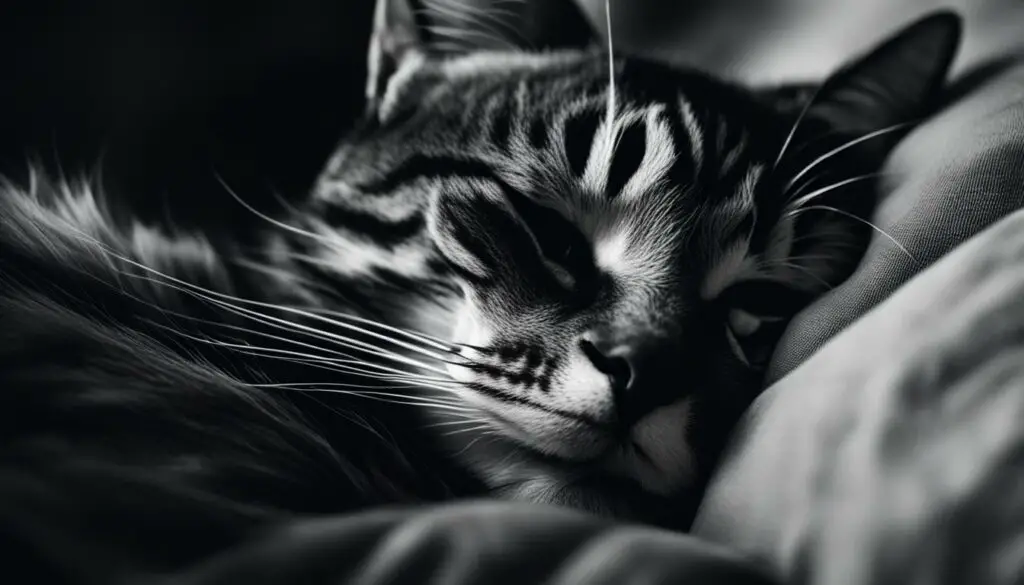Have you ever woken up to find your cat gently placing her paw on your face? It may seem like a peculiar behavior, but it actually holds deeper meaning. In this article, we will explore why cats engage in this affectionate gesture and what it means for your cat-human interaction.
Key Takeaways:
- Cats pawing at your face is a sign of affection and trust.
- It’s their way of seeking comfort and expressing their bond with you.
- Cat behaviors like pawing and kneading have different meanings and purposes.
- Understanding cat body language can help you respond to their needs and emotions.
- Setting boundaries and training can enhance your cat-human relationship.
The Significance of Cat Behaviors
Cats are fascinating creatures that exhibit a wide range of behaviors to communicate with their surroundings and their human companions. Understanding these behaviors is essential for strengthening the bond between you and your furry friend. From pawing at your face to chattering at birds, each behavior serves a unique purpose in feline communication.
Listed below are some common cat behaviors and their significance:
- Pawing at your face: When a cat puts her paw on your face while you sleep, it is primarily a sign of affection and trust. It is their way of seeking comfort, marking their territory with scent glands in their paws, and expressing their bond with you. This behavior shows that they feel safe and secure with you as their human companion.
- Kneading: Kneading is a behavior in which cats push their paws in and out against a soft surface, such as a blanket or your lap. This behavior is reminiscent of their kittenhood and signifies contentment and bonding. Cats also use kneading to mark their scent and show trust.
- Chattering at birds: When your cat sees birds outside the window and makes a chattering sound, it is a sign of excitement and frustration. This behavior is thought to mimic the sound cats make when they catch prey, showing their hunting instincts.
- Bringing you “gifts”: Cats often bring their owners “gifts” in the form of dead mice, birds, or other small animals. While it may not be pleasant for us, it is rooted in their hunting instinct and serves as a bonding behavior. It shows their trust and acceptance of you as part of their social group.
- Hiding in boxes: Cats have a natural affinity for boxes and will often seek them out as hiding spots. This behavior serves as a way for them to feel safe and secure, as boxes provide a sense of enclosure and protection.
“Cats exhibit a wide range of behaviors that serve as their unique way of communicating with their environment and their human companions.”
By observing and understanding these behaviors, you can better respond to your cat’s needs and emotions, strengthening your bond and creating a harmonious relationship. Each behavior offers valuable insights into your cat’s world, allowing you to provide the care and attention they require.
| Behavior | Significance |
|---|---|
| Pawing at your face | Affectionate gesture, marking territory, expressing trust |
| Kneading | Comfort behavior, bonding, scent marking |
| Chattering at birds | Excitement, hunting instincts |
| Bringing you “gifts” | Bonding behavior, prey behavior, trust |
| Hiding in boxes | Feeling safe and secure |
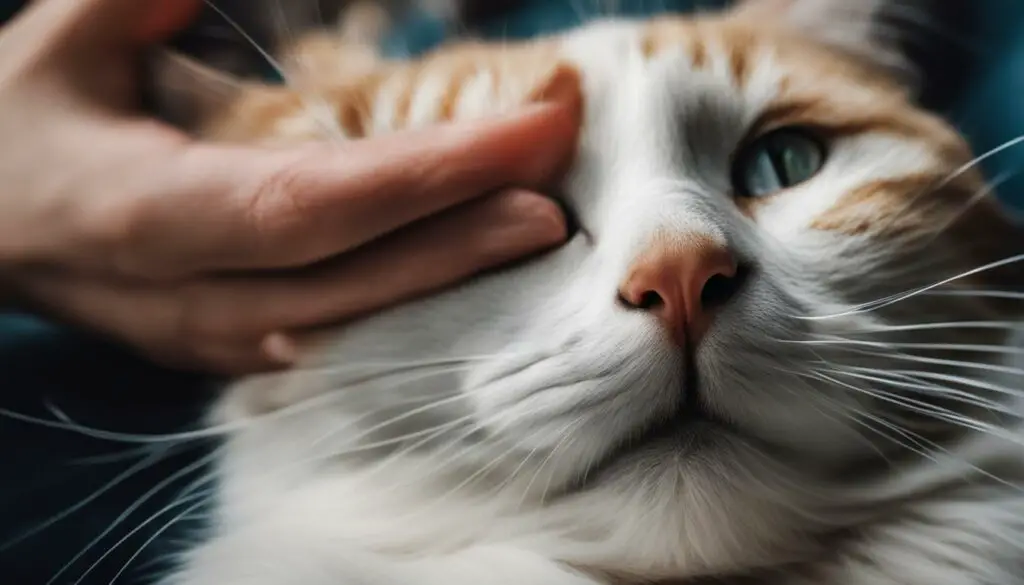
Cat Gestures: Understanding Your Feline Friend’s Body Language
Cats are known for their mysterious and captivating body language. By decoding their gestures, you can gain deeper insights into their emotions and needs. Understanding cat gestures is essential for building a strong bond with your furry friend. Let’s explore some common cat gestures and their meanings:
Facial Expressions:
Cats communicate a range of emotions through their faces. A relaxed face with half-closed eyes and a slightly open mouth indicates contentment and trust. On the other hand, dilated pupils and a tense expression can signify fear or aggression. Pay attention to your cat’s facial cues to better understand their mood.
Body Posture:
Just like humans, cats use their body posture to express themselves. An arched back accompanied by a fluffed-up tail suggests fear or aggression. Conversely, a relaxed body with a gently swaying tail indicates that your cat is calm and content. Observing their body posture can help you gauge their comfort level and respond accordingly.
Tail Language:
The position and movement of a cat’s tail can convey a wealth of information. A vertical tail held high signifies confidence and friendliness. A swishing or twitching tail can indicate agitation or annoyance. Pay attention to your cat’s tail language to gauge their overall mood and well-being.
| Gestures | Meanings |
|---|---|
| Face with paws | Seeking attention or showing affection. |
| Tail flicking rapidly | Annoyance or agitation. |
| Purring | Contentment and relaxation. |
| Slow blinking | Trust and affection. |
| Arching the back | Feeling threatened or scared. |
| Rubbing against you | Marking territory and showing affection. |
| Laying on their back | Feeling safe and comfortable. |
| Hissing or growling | Fear or territorial behavior. |
Understanding these cat gestures will help you respond appropriately to your cat’s needs and emotions. By paying attention to their body language and facial expressions, you can nurture a deeper connection and enhance the bond between you and your feline companion.
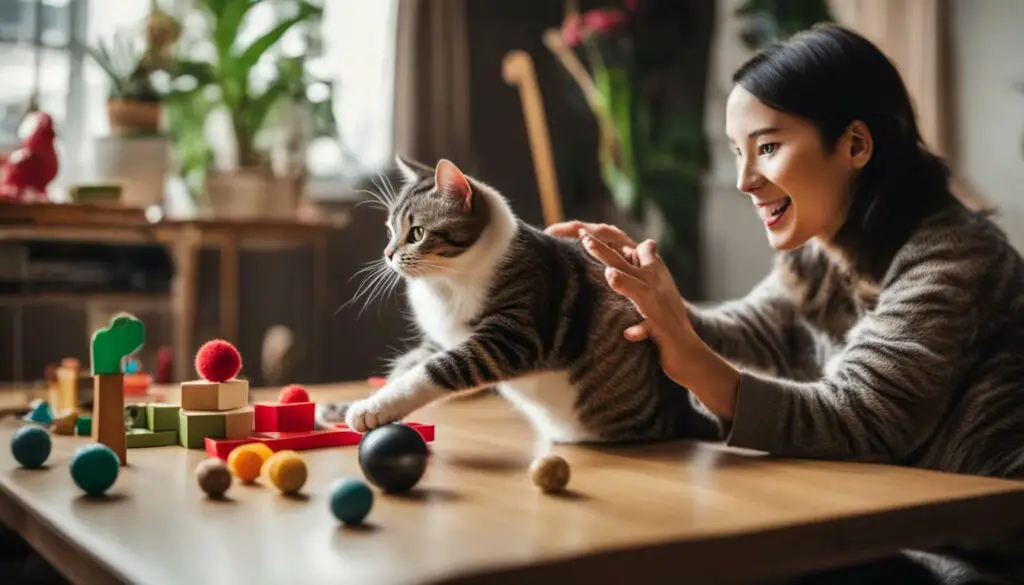
Understanding Your Cat’s Body Language
Observing your cat’s body language can provide valuable insights into their moods and emotions. By paying attention to their tail, eye contact, whiskers, body posture, and vocal cues, you can better understand what they are trying to communicate.
Tail
The position and movement of a cat’s tail can indicate their current state of mind. A relaxed and slightly curved tail usually signifies a content and comfortable cat. On the other hand, a fluffed-up tail can indicate fear or aggression. Pay attention to the speed and direction of tail movements as well, as rapid flicking often suggests annoyance or agitation.
Eye Contact
Eye contact plays a significant role in cat communication. Direct and steady eye contact can convey a sense of confidence and trust. However, prolonged staring or dilated pupils may indicate fear or aggression. Cats also use slow blinking as a sign of affection and trust, so reciprocating with a slow blink may help strengthen your bond.
Whiskers
Cats use their whiskers as tactile sensors to navigate their surroundings. When their whiskers are relaxed and positioned forward, it indicates a calm and curious cat. However, if their whiskers are flattened against their face, it may indicate fear or discomfort.
Body Posture
Pay attention to your cat’s overall body posture to gauge their emotions. A relaxed and loose posture suggests comfort and contentment, while a tense and hunched position may indicate fear or stress. If your cat arches their back, it is a sign of feeling threatened or scared. Conversely, if they roll onto their back, it usually signifies trust and comfort.
Vocal Cues
Cats use various vocalizations to communicate their needs and emotions. Different meows, purrs, hisses, or growls can indicate different feelings. For example, a soft and melodic purr usually indicates contentment, while a hiss or growl is a sign of fear or territorial behavior.
By familiarizing yourself with these aspects of your cat’s body language, you can develop a deeper understanding of their behaviors and build a stronger bond with them.
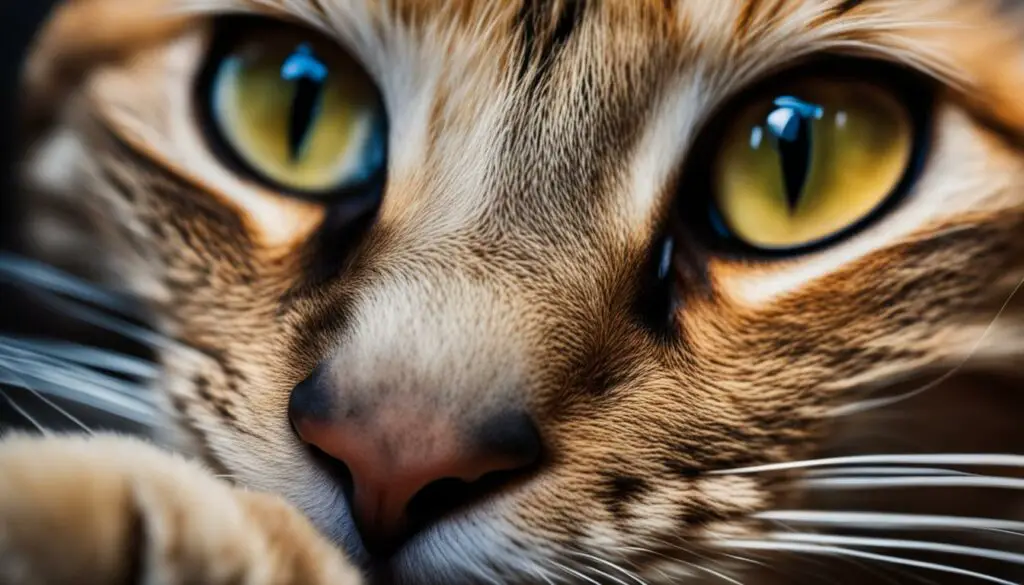
Is Paw on the Face a Sign of Affection or Dominance?
When a cat places its paw on your face, it is usually a sign of affection. It is their way of connecting with you and showing trust. Cats have scent glands in their paws, and by touching your face, they are leaving their scent on you, marking you as part of their territory.
However, it’s important to consider the context. While pawing at your face is generally an affectionate behavior, cats may also use other parts of their body to establish dominance or mark their territory. It’s essential to observe their body language and overall behavior to understand their intentions fully.
Remember that every cat is unique, and their behaviors may vary. Some cats may display dominant behaviors like swatting or scratching, while others may be more gentle and affectionate. It’s important to set boundaries and redirect any aggressive or unwanted behaviors through positive reinforcement and training techniques.
Table: Affectionate Behavior vs. Dominant Behavior in Cats
| Behavior | Affectionate | Dominant |
|---|---|---|
| Paw on the face | Expresses trust and connection | May be used for territorial marking |
| Purring | Sign of contentment and relaxation | Can also be a sign of anxiety or stress |
| Head bumps | Shows friendship and affection | May be used for marking territory |
| Playful biting or nibbling | Expresses affection and playfulness | Can be a sign of overstimulation or aggression |
Understanding your cat’s individual temperament and the context of their behaviors is key to interpreting whether their paw on your face is an affectionate gesture or a display of dominance. By observing their overall body language and considering their unique personality, you can strengthen your bond with your feline friend and ensure a harmonious relationship.
How Cats Use Their Paws to Communicate
Cats are known for their unique ways of communicating with their human companions. One fascinating aspect of their communication is how they use their paws in various situations. Let’s explore the different ways cats use their paws to express themselves and interact with their environment.
1. Tactile Sensitivity:
Cats have highly sensitive paws that allow them to gather information about their surroundings through touch. They use their paws to tap or touch objects, including your face, out of curiosity. This tactile sensitivity helps them explore and understand the world around them.
2. Scent Marking:
Another way cats use their paws is through scent marking. Cats have scent glands located in their paws, and when they touch objects or people, they leave behind their unique scent. By doing so, they are marking their territory and creating a familiar scent that brings them comfort.
3. Communication with other cats:
Cats also use their paws to communicate with other cats. When cats engage in gentle paw touches, it is a way for them to establish social bonds and communicate their intentions. It’s their version of a friendly handshake or a gesture of camaraderie.
Understanding how cats use their paws to communicate can deepen our bond with them and enhance our understanding of their needs and emotions. By observing their paw-related behaviors, we can gain insights into their world and strengthen our connection with these fascinating creatures.
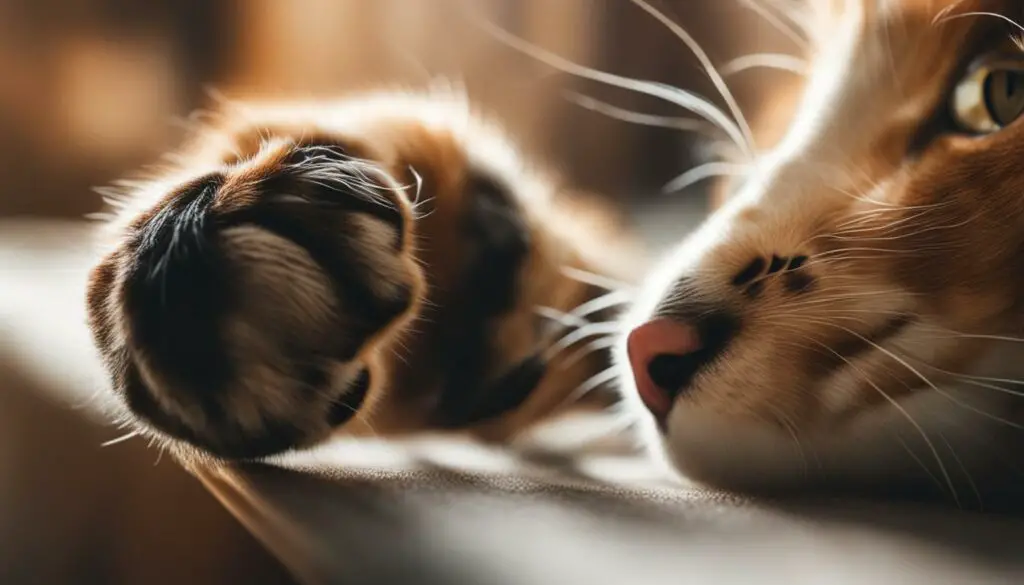
| Behavior | Explanation |
|---|---|
| Tactile Sensitivity | Cats use their paws to explore their environment and gather information through touch. |
| Scent Marking | By touching objects or people, cats leave behind their scent, marking their territory and creating familiarity. |
| Communication with other cats | Gentle paw touches with other cats signify social bonding and friendly intentions. |
The Role of Grooming Behavior
Grooming behavior in cats serves multiple purposes, including sensory exploration and bonding. Cats groom themselves to regulate their body temperature, enhance blood circulation, and keep their fur clean. Additionally, when a cat grooms another cat or their human companion, it is a social activity that expresses friendship and strengthens the bond between them.
“Grooming is an important behavior for cats, both for their physical well-being and social interactions. It not only helps them maintain their coat but also allows them to communicate and show affection towards their human companions.”
During grooming, cats use their tongues to remove dirt and debris from their fur. This behavior also helps them distribute natural oils throughout their coat, keeping it healthy and shiny. When your cat grooms you, they are marking you as part of their family and sharing their sense of comfort and belonging.
Observing your cat’s grooming behavior can provide insights into their well-being. Excessive grooming or changes in grooming habits may indicate stress, anxiety, or an underlying health issue. If you notice any unusual grooming behaviors, it is advisable to consult a veterinarian for further evaluation.
| Grooming Behavior | Purpose |
|---|---|
| Self-grooming | Regulates body temperature, enhances blood circulation, removes dirt and debris, distributes natural oils |
| Grooming others | Expresses friendship, strengthens social bonds, marks individuals as part of the family |
Overall, grooming behavior is an essential aspect of a cat’s life. It not only keeps them physically healthy but also contributes to their emotional well-being and strengthens the bond between cats and their human companions.
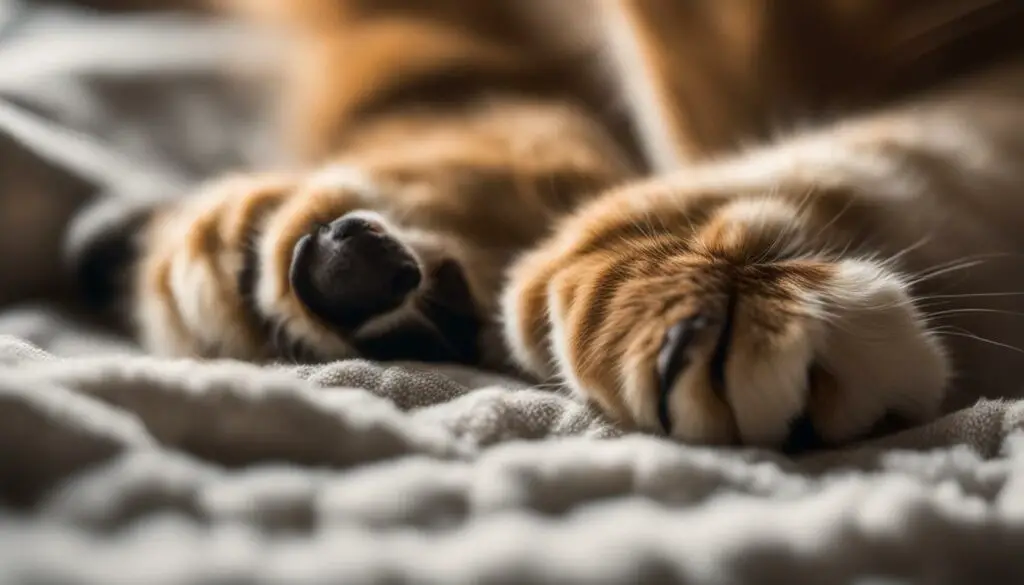
Why Cats Bring “Gifts”
One peculiar behavior that cats display is bringing “gifts” to their human companions. While it may not be the most pleasant surprise to find a dead mouse or bird on your doorstep, this behavior is rooted in their hunting instinct and serves as a form of bonding.
Cats are natural-born hunters, and by bringing you these “gifts,” they are essentially teaching you how to hunt as they would with another cat. It’s their way of sharing their prey behavior and including you as part of their social group. So, while it may seem odd to us, it’s a sign of trust and an expression of their affection.
However, it’s important to note that not all cats exhibit this behavior, and it can vary among individuals. Some cats may never bring you a gift, while others may do so frequently. It all depends on their personality, hunting drive, and the environment they live in. Regardless, it’s essential to appreciate their intentions and the bond they are trying to establish through this behavior.
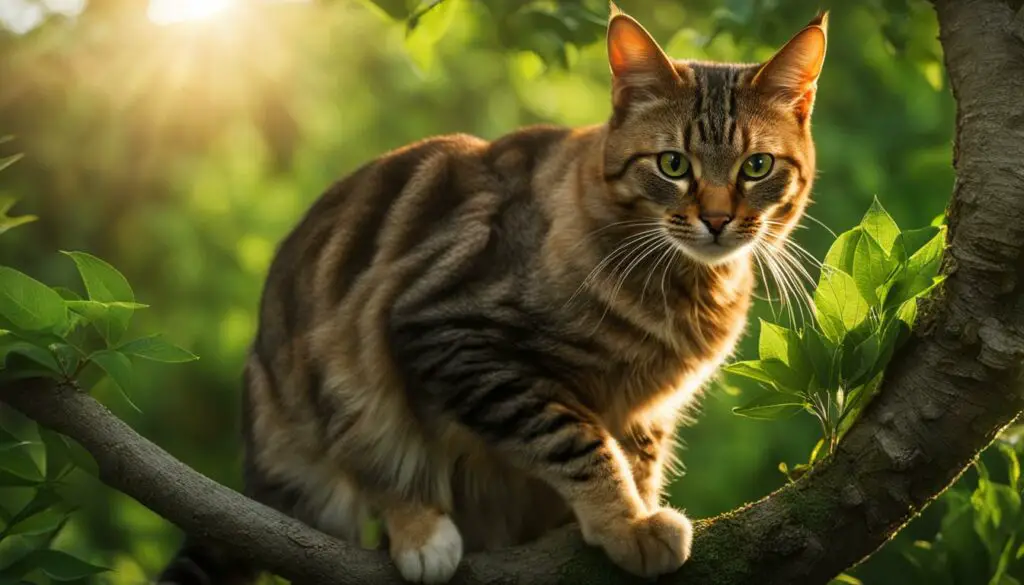
| Behavior | Description |
|---|---|
| Bringing “Gifts” | A cat’s way of sharing their prey behavior and including you in their social group. |
| Varying Frequency | Not all cats will bring gifts, and the frequency can vary among individuals. |
| Expression of Trust | This behavior signifies trust and is an expression of affection from your cat. |
So, the next time your furry friend brings you a “gift,” remember to appreciate their effort and the bond they are trying to create. While it may not be what we consider a traditional gift, it’s a unique way for cats to show their love and include you in their hunting instincts.
The Affectionate Nature of Kneading
When your cat kneads you or a soft surface with their paws, it is not just a random behavior. Kneading is a comfort behavior that harkens back to their kittenhood. It is a gentle, rhythmic motion where they push their paws in and out on the chosen surface, whether it’s your lap, a blanket, or a plush toy. This behavior is often accompanied by purring, a content expression, and a relaxed body posture. So, why do cats knead?
Kneading is a bonding behavior that signifies both comfort and trust. When a cat kneads you, they are essentially reenacting their kittenhood, when they would knead their mother’s belly to stimulate milk production. In this way, it is a nostalgic behavior that brings them a sense of comfort and security. Kneading also helps them mark their scent, as they have scent glands in their paws. By kneading, they are leaving their unique scent on you, reinforcing the bond between you and your feline friend. It’s their way of saying, “You are part of my family.”
However, it’s important to be cautious of your cat’s claws during kneading. Some cats may not retract their claws fully while kneading, which can lead to accidental scratches. To prevent any injuries, keep your cat’s nails trimmed regularly and provide them with appropriate scratching surfaces. You can also place a soft blanket or towel on your lap when you anticipate your cat’s kneading behavior. This way, they can still engage in their comforting ritual while minimizing the risk of scratches.
| The Affectionate Nature of Kneading | |
|---|---|
| Key Behavior | Kneading |
| Behavior Type | Comfort behavior |
| Function | Bonding behavior |
| Benefits | 1. Comfort and relaxation for the cat 2. Marking territory and scent bonding 3. Strengthening the bond with the owner |
“Kneading is a comforting behavior that signifies contentment and bonding.” – Dr. Emily Thompson, Veterinary Behaviorist
Interaction Through Facial Recognition
When it comes to building a strong bond with your cat, facial recognition plays a significant role. Cats rely on their sense of smell and touch to explore your face and establish trust. The act of a cat touching your face with their paw is an intimate gesture that allows them to familiarize themselves with your scent and connect with you on a deeper level.
Facial recognition is not only a sensory exploration for cats but also a means of communication. By touching your face, cats are expressing their desire for closeness and affection. It’s their way of saying, “I trust you.” This behavior creates a sense of bonding, strengthening the connection between you and your feline companion.
As you engage in this interaction through facial recognition, remember to reciprocate with love and care. Responding positively to your cat’s affectionate gestures, such as gentle strokes or soft spoken words, affirms the trust they have placed in you. This builds a foundation for a lasting relationship based on mutual understanding and companionship.
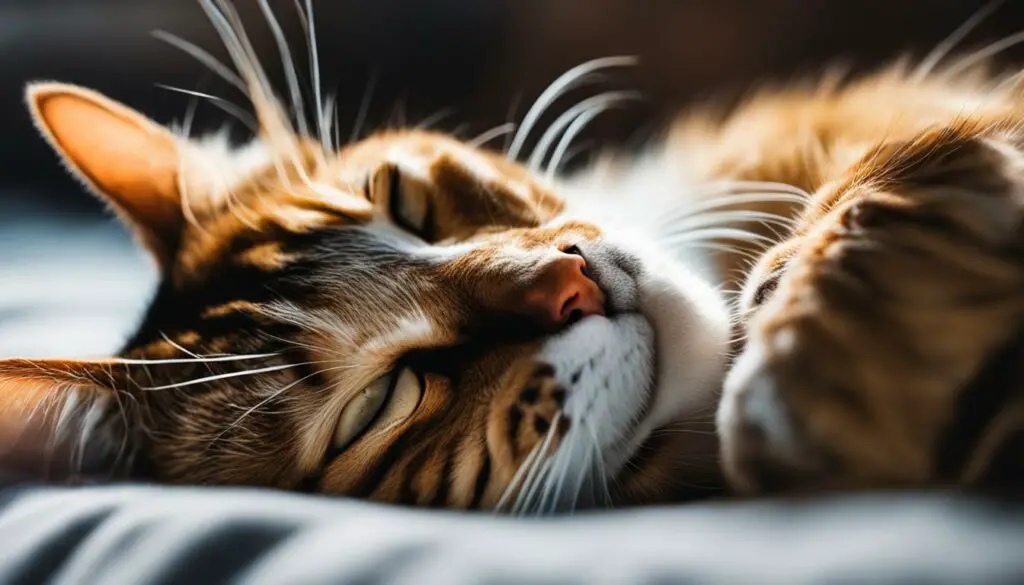
So, the next time your cat reaches out and touches your face with their paw, embrace this moment as a sign of their love and trust. Take the time to engage in this intimate form of communication and continue nurturing the bond you share. Through facial recognition, cats connect with us in their unique way, reminding us of the special connection we have with these incredible creatures.
Responding to Your Cat’s Affection
When your cat affectionately puts her paw on your face while you sleep, it’s essential to respond appropriately to maintain a harmonious relationship. Understanding cat-human interaction is crucial to ensure both you and your furry friend feel comfortable and respected. Here are some tips for setting boundaries and training your cat:
1. Establish Clear Communication
Setting boundaries with your cat starts with clear communication. Gently redirect their behavior when they paw at your face during inappropriate times, such as while you’re working or eating. Use a calm, firm voice and say “no” or “stop” to let them know their actions are not acceptable. Consistency is key in reinforcing these boundaries.
2. Provide Alternative Outlets
Cats often use their paws to seek attention or show affection. Provide alternative ways for them to express these behaviors. Encourage interactive play sessions with toys, such as wand toys or feather teasers, to redirect their energy in a positive manner. This helps fulfill their need for stimulation and bonding.
3. Use Positive Reinforcement
Reward your cat for desirable behavior to reinforce positive actions. When they engage in appropriate interactions, such as gentle head bumps or purring, offer treats or praise as positive reinforcement. This encourages them to repeat these behaviors and strengthens your bond over time.
| Setting Boundaries | Training Your Cat |
|---|---|
| Establish clear communication | Use positive reinforcement |
| Provide alternative outlets | Encourage interactive play sessions |
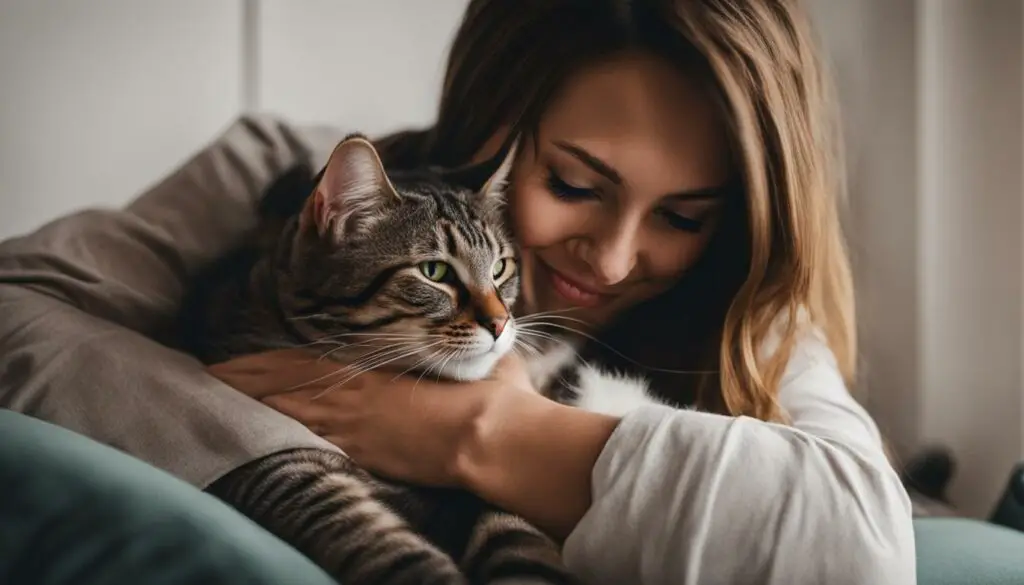
“Understanding your cat’s needs and responding appropriately is essential for a loving and respectful relationship.”
Remember that each cat is unique, and it may take time for them to understand and respect the boundaries you establish. Patience, consistency, and positive reinforcement are key in training your cat and strengthening your bond. By responding to your cat’s affection in a thoughtful and respectful manner, you’ll create a nurturing environment for both you and your furry friend.
The Role of Biting and Pawing in Affection
Cats have unique ways of expressing their affection, and one of them involves biting and pawing. While it may seem contradictory, these behaviors are rooted in their instinctual play behavior and their desire to engage with their human companions. Understanding the role of biting and pawing in affection can help strengthen the bond between you and your feline friend.
Biting behavior: Love bites, also known as gentle nibbles, are a common way for cats to show their affection. They may lightly bite your hand or arm during play, grooming sessions, or moments of closeness. This behavior mimics their natural hunting instincts and is their way of demonstrating trust and familiarity. However, it’s important to monitor their intensity and redirect their biting towards appropriate toys or surfaces.
Play behavior: Cats engage in play behavior to release energy, stimulate their minds, and strengthen their bond with their human companions. During play sessions, cats may use their paws to bat at toys, your hands, or even gently tap your face. This is an expression of their playful nature and their desire to interact with you. Encouraging interactive play, such as using feather wands or laser pointers, can provide a positive outlet for their energy and deepen your connection.
“Biting behavior and pawing are natural ways for cats to express their affection and playfulness.”
– Dr. Sarah Thompson, Feline Behavior Specialist
The Importance of Positive Reinforcement
When dealing with biting and pawing behaviors, it’s crucial to use positive reinforcement techniques. Avoid punishing or scolding your cat, as this can create fear and damage the trust you’ve built. Instead, redirect their biting and pawing towards appropriate toys or surfaces and reward them with praise and treats when they engage in desired behaviors. This not only helps them understand boundaries but also reinforces the positive aspects of your relationship.
| Behavior | Description |
|---|---|
| Biting | Gentle nibbles to show affection and familiarity |
| Pawing | Playful tapping or batting with the paws |
| Positive Reinforcement | Rewarding desired behaviors with praise and treats |
By understanding and responding to your cat’s biting and pawing behaviors with patience and positive reinforcement, you can strengthen the bond you share. Remember to provide appropriate outlets for their natural instincts and engage in interactive play sessions. With time and consistent positive reinforcement, you and your cat can enjoy a loving and affectionate relationship.
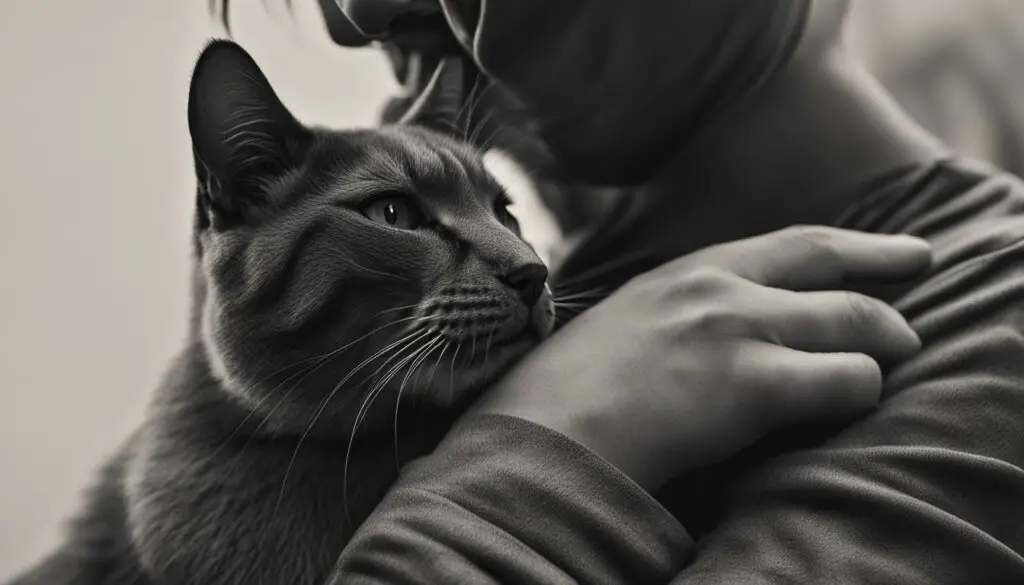
The Enduring Bond Between Cat Owners and Their Feline Friends
Cats have a unique way of forging deep connections with their human companions. Despite their independent nature, these enigmatic creatures engage in affectionate behaviors that strengthen the bond between them and their owners. One such behavior is when a cat places its paw on your face while you sleep. This act of trust and affection is a testament to the enduring bond between cat owners and their feline friends.
When a cat gently touches your face with its paw, it is seeking a deeper connection with you. It is their way of expressing love, comfort, and trust. This subtle gesture demonstrates that they feel safe in your presence and solidifies the bond you share. By inviting you into their personal space, they are acknowledging you as a valued member of their social group.
This affectionate behavior is representative of the strong social bonding that cats form with their human owners. Just like humans, cats thrive on companionship and seek emotional security. By reciprocating their affection and providing them with a safe and loving environment, you are nurturing this bond and creating a lasting connection.

Building trust is a crucial aspect of the cat-owner bond. Trust is established through consistent care, attention, and positive interactions. By understanding and responding to their needs, you can foster a sense of security and strengthen the relationship. Trust-building activities such as grooming, interactive play, and providing a stimulating environment can further deepen the bond between you and your feline friend.
Conclusion
Understanding cat behavior and the affectionate gestures they display, such as placing their paw on your face, is crucial for building a strong bond with your feline friend. This behavior is primarily a sign of love and trust, as cats seek comfort and express their attachment to their human companions.
By decoding their body language and recognizing gestures like face with paws, slow blinking, and tail flicking, you can better respond to your cat’s needs and emotions. Observing their tail, eye contact, whiskers, body posture, and vocal cues provides insights into their moods and intentions.
While pawing at your face may seem odd, it is their way of connecting with you and leaving their scent as a mark of territory. Cats use their paws in various ways to communicate, explore their surroundings, and show affection. Grooming behavior, bringing “gifts,” kneading, and even facial recognition all play a role in strengthening the bond between you and your feline companion.
When responding to your cat’s affectionate behaviors, setting boundaries and training can help maintain a harmonious relationship. By establishing clear communication and mutual respect, you can further enhance your bond with your cat, ensuring a lasting and loving connection.
FAQ
Why does my cat put her paw on my face when I sleep?
When a cat puts her paw on your face while you sleep, it is primarily a sign of affection and trust.
What are some common cat behaviors?
Some common cat behaviors include pawing at your face, kneading, chattering at birds, bringing you “gifts,” and hiding in boxes.
How do cats communicate through body language?
Cats communicate a lot through their body language. Understanding their gestures can help you respond to their needs and emotions.
What are some common cat gestures?
Some common cat gestures include face with paws (seeking attention or showing affection), tail flicking rapidly (annoyance or agitation), purring (contentment), slow blinking (trust and affection), arching the back (feeling threatened or scared), rubbing against you (marking territory), laying on their back (trust and comfort), and hissing or growling (fear or territorial behavior).
How can I understand my cat’s body language?
By observing their tail, eyes, whiskers, body posture, and vocal cues, you can gain insights into their feelings and emotions.
What does it mean when a cat puts its paw on my face?
When a cat places its paw on your face, it is usually a sign of affection and trust. They are connecting with you and establishing a bond.
How do cats use their paws to communicate?
Cats use their paws to explore their surroundings, mark territory with scent glands, and tap or touch objects out of curiosity.
Why do cats groom me?
Cats groom as a social activity to express friendship and bond with their human companions. It is a way for them to mark you as part of their family.
Why do cats bring me “gifts”?
Cats bringing you “gifts,” such as dead mice or birds, is rooted in their hunting instinct. It shows their bond and trust in you as part of their social group.
What does it mean when a cat kneads me?
When a cat kneads you or a soft surface, it signifies contentment and bonding. It is a comforting behavior that shows trust.
How do cats use facial recognition to interact with me?
Cats rely on facial recognition to identify their human companions. By touching your face with their paw, they familiarize themselves with your scent and connect with you.
How should I respond when my cat paws at my face?
It is important to set boundaries by gently redirecting their behavior or training them to understand appropriate social interactions. Clear communication and mutual respect are key.
Why do cats sometimes bite or paw at me?
Love bites or gentle nibbles are a unique way for cats to express affection. While some cats may engage in biting and pawing as part of their play behavior, it is important to monitor their intensity and redirect their energy appropriately.
How strong is the bond between cat owners and their cats?
The bond between cat owners and their feline friends is strong and enduring. Despite their independent nature, cats form deep connections with their human companions through affectionate behaviors like pawing at the face.

